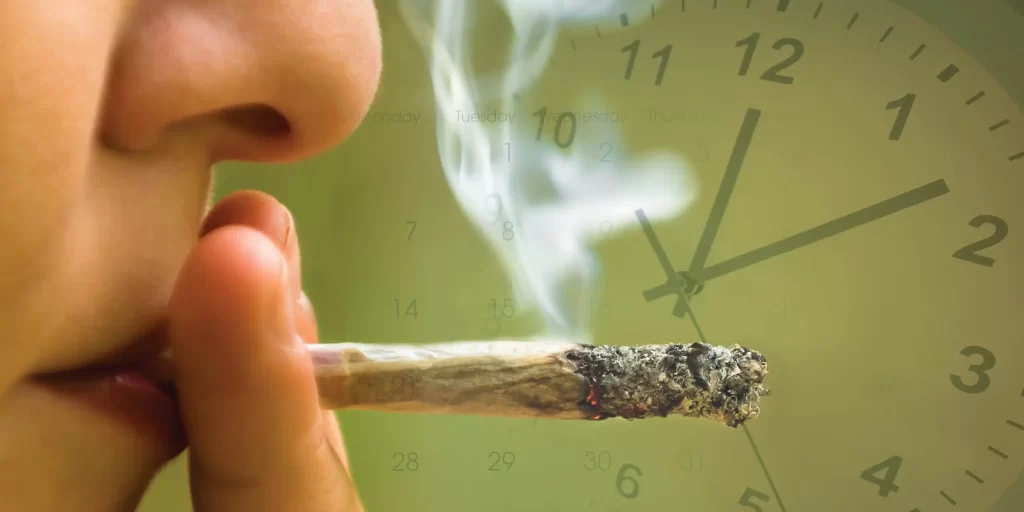How Long Does Weed Stay in Your System?
Written by Erica Weiman
& Medically Reviewed by Dr. Jessica Pyhtila, PharmD
Medically Reviewed
Up to Date
Last Updated - 6/17/2022
View our editorial policy
With marijuana becoming decriminalized in many states, the topic of drug testing has become more important than ever. Marijuana, also known as weed or pot, seems to have fallen into a gray area where some employers continue to test for it and others have stopped.
Marijuana, or cannabis, contains dozens to hundreds of active chemicals that have different effects within the body. Marijuana contains unique chemicals called cannabinoids. This chemical category affects a cellular pathway in the body called the endocannabinoid system.
Drug testing and how long weed stays in the system revolves around tetrahydrocannabinol (THC). THC is the molecule that causes intoxication, euphoria, relaxation and changes to sensory perception. THC can stay in the body for several days and even weeks, long after it has stopped producing the intended effects.
How Long Does it Take for Weed to Kick In?
It can take weed varying amounts of time to kick in, depending on how the person is consuming weed. It is available in many different forms, including leaves, oil, wax, edibles and tinctures.
If a person smokes weed, a high will kick in almost immediately. This is because the drug passes directly into the bloodstream and is carried to the brain.
However, if a person consumes marijuana by mouth in a food or beverage, a weed high can take 30 minutes to one hour to kick in since the marijuana goes through the digestive system before entering the bloodstream.
Regular consumption of marijuana can lead to tolerance, meaning that the body gets used to it and the person needs more to achieve the same effects. For this reason, people who take marijuana on a regular basis may experience less of a high than those who only use it infrequently. In some cases, someone who consumes marijuana frequently may have no high at all after using the drug.
How Long Does a Marijuana High Last?
A person will feel the effects of weed for about one to three hours when smoked. However, ingesting it in food or drinks can produce effects that last for many hours. This is because marijuana taken by mouth releases slowly in the stomach and intestines, prolonging the effect.
THC Half-Life
A half-life is how long the body takes to metabolize half the amount of an ingested drug. The half-life of marijuana varies based on frequency of use. People who use marijuana infrequently can expect a half-life of about 1.3 days, but the half-life for people who use marijuana frequently is between five and 13 days.
For example, if someone who doesn’t use marijuana often takes 10 mg on Monday, they could have 5 mg left at the end of Tuesday and 2.5 mg still in their blood on Wednesday. Someone who uses marijuana more frequently may have 5 mg in their blood by Friday and possibly into the following week.
Based on the half-life, someone who doesn’t consume marijuana often will clear THC completely in about seven days, and more frequent use can take up to 65 days.
THC and other cannabinoids are broken down by the liver. Liver cells make small proteins called enzymes that break down substances, including THC. THC is then broken down into some products that continue to be active and cause a high in your body, such as 11-OH-THC, or 11-hydroxy-delta-tetrahydrocannabinol. This is one of the reasons that traces of marijuana can last so long in your body.
How Long Does Marijuana Stay in Your System?
Weed detection times vary based on the type of test. Drug screens can be performed using urine, saliva, blood or hair. The detection window ranges from a few days to several weeks, but some tests can detect it for months.
How Long Does Marijuana Stay in Urine?
Marijuana stays in urine in proportion to how often the person uses it. For example, if a person uses weed once a week, traces of weed remain in urine for up to 10 days. However, urine drug tests can detect it for up to 30 days in someone who consumes weed daily, although some labs may be able to detect it for up to 45 days.
Urine drug screens are cheap, easy and noninvasive. Most employers prefer this type of drug screen over more expensive options.
How Long Does Marijuana Stay in Your Blood?
The marijuana blood test detection time is about 12 hours after last use.
How Long Does Marijuana Stay in Your Hair?
A 1.5-inch hair sample can show if THC was used within the past 90 days. A hair test is unique because the detection window depends on the growth speed of hair, not how quickly the body metabolizes the drug. When THC is present in the bloodstream, it deposits into hair follicles. Deposited THC stays locked in the hair, only leaving when hair is cut off.
How Long Does Marijuana Stay in Your Saliva?
A marijuana saliva test can detect THC for up to 24 hours. The small detection window makes saliva testing a poor option.
How Long Does Marijuana Stay in Breastmilk?
Weed has been found in breast milk for varying amounts of time, ranging from six hours to six weeks depending on the study. It remains unclear whether using weed while breastfeeding has any short or long-term impact on a baby’s health or development, as studies have conflicting results. For this reason, to be safe, experts recommend against using weed if you breastfeed.
Factors Affecting How Long Marijuana Stays in Your System
THC metabolism is very complex, but we know a few key characteristics that help understand THC in the body.
- Amount used: Higher usage makes THC accumulate in the body, especially in fat. Since the body can only metabolize so much THC at a time, accumulation slows down metabolism.
- Frequency of use: THC accumulates in people using it frequently or for long periods. Accumulated THC has a longer half-life than short-term usage, and the body takes more time to remove it.
- Metabolism rate: Marijuana and metabolism are mostly linked by usage. Among people who consume marijuana frequently and in large amounts, the half-life of marijuana ranges from five to 13 days. Because it takes about five half-lives to fully remove a drug from your body, this means that THC can be removed from the body in one month, but it may take up to two months.
- Body fat percentage: THC is lipophilic, meaning it is soluble in fat solutions but not water solutions. People with a higher body fat percentage may metabolize pot more slowly than others.
Marijuana False Positives
Some drug screens return with a positive result even when the person has not consumed THC. If a substance that is not THC triggers a positive result, this is called a false positive.
Any test has the potential for a false positive, but research has confirmed a few factors that impact urine drug screens.
Most marijuana false positives are caused by the presence of other substances, including:
- Hemp foods
- Over-the-counter pain medications like ibuprofen and naproxen
- Pantoprazole, an acid reflux medication
- Sustiva and HIV medication
If a drug test comes back positive, the person is asked about other medications they take to rule out false positives. The urine sample is then sent to another lab for a test called gas chromatography-mass spectrometry, or GC-MS. GC-MS can confirm the sample with almost 100% accuracy, so a false positive drug screen must be confirmed with this type of test.
Error: Contact form not found.
How Long Does Marijuana Withdrawal Last?
If someone who uses marijuana heavily and frequently suddenly stops, withdrawal is possible as the body struggles to adjust to being without the drug. Marijuana withdrawal symptoms often start within 24 to 72 hours after the most recent use and peak within the first week. Overall, marijuana withdrawal lasts about one to two weeks. However, over the first two months, insomnia and strange dreams may continue.
Marijuana withdrawal symptoms can include:
- Marijuana cravings
- Thirst
- Dry mouth or throat
- Hunger
- Mellow feelings
- Increased appetite
- Increased sex drive
- Strange or vivid dreams
- Irritability
- Anger
- Restlessness
- Depression
- Anxiety
Marijuana Abuse
Marijuana abuse is common, and weed is the most commonly used Schedule I controlled substance in the United States. About 18% of Americans used weed in 2019 alone, and approximately 30% of regular consumers have a marijuana use disorder. For this reason, it’s important to be aware of signs of marijuana abuse, such as:
- Spending an excessive amount of time using or trying to obtain marijuana
- Focusing on marijuana to the detriment of other responsibilities like school and work
- Unsuccessfully trying to quit or cut back on marijuana
- Having legal or financial troubles linked to marijuana
- Continuing to use marijuana despite understanding negative effects on your life
Marijuana Addiction Help
If you or a loved one is ready to stop using weed, The Recovery Village Ridgefield is here to help. Our detox facility can help you handle withdrawal safely, followed by marijuana rehab programs that can help you achieve successful recovery. Our rehab options are tailored to the level of care you need and include inpatient, outpatient and partial hospitalization programs.
We believe in a holistic mind-and-body approach to help overcome substance use disorders. Our on-site amenities include art and music therapy, gyms, a basketball court and more.
Contact us today to learn more about treatment plans that can work well for you.
Sources
View Sources
National Institute on Drug Abuse. “What are marijuana’s effects?” Cannabis (Marijuana) Research Report, July 2020. Accessed March 17, 2022. Colizzi, M; Bhattacharyya, S. “Cannabis use and the development of tolerance: a systematic review of human evidence.” Neuroscience and Biobehavioral Reviews, October 2018. Accessed March 17, 2022. Oberbarnscheidt, T; Miller, NS. “Pharmacology of Marijuana.” Journal of Addiction Research & Therapy, 2017. Accessed March 17, 2022. Turner, AR; Spurling, BC; et al. “Marijuana Toxicity.” StatPearls, August 2, 2021. Accessed March 17, 2022. Hallare, J; Gerriets, V. “Half Life.” StatPearls, August 23, 2021. Accessed March 17, 2022. Gryczynski, J; Schwartz, RP; et al. “Hair Drug Testing Results and Self-reported Drug Use among Primary Care Patients with Moderate-risk Illicit Drug Use.” Drug and Alcohol Dependence, May 17, 2014. Accessed March 17, 2022. ARUP Laboratories. “Drug Plasma Half-Life and Urine Detection Window.” October 2021. Accessed March 17, 2022. Cone, EJ; Huestis, MA. “Interpretation of Oral Fluid Tests for Drugs of Abuse.” Annals of the New York Academy of Sciences, March 1, 2007. Accessed March 17, 2022. National Library of Medicine. “Cannabis.” Drugs and Lactation Database (LactMed), November 15, 2021. Accessed March 17, 2022. Ferguson, MC. “False-Positive Screen for Marijuana.” Practical Pain Management, May 2015. Accessed March 17, 2022. Substance Abuse and Mental Health Services Administration (SAMHSA). “Protracted Withdrawal.” Substance Abuse Treatment Advisory: News for the Treatment Field, July 2010. Accessed March 17, 2022. PsychDB. “Cannabis Withdrawal.” March 29, 2021. Accessed March 17, 2022. U.S. Centers for Disease Control and Prevention (CDC). “Data and Statistics.” June 8, 2021. Accessed March 17, 2022. Lee, D; Schroeder, JR; et al. “Cannabis Withdrawal in Chronic, Frequent Cannabis Smokers during Sustained Abstinence within a Closed Residential Environment.” The American Journal on Addictions, May 2014. Accessed March 17, 2022.
Authorship






